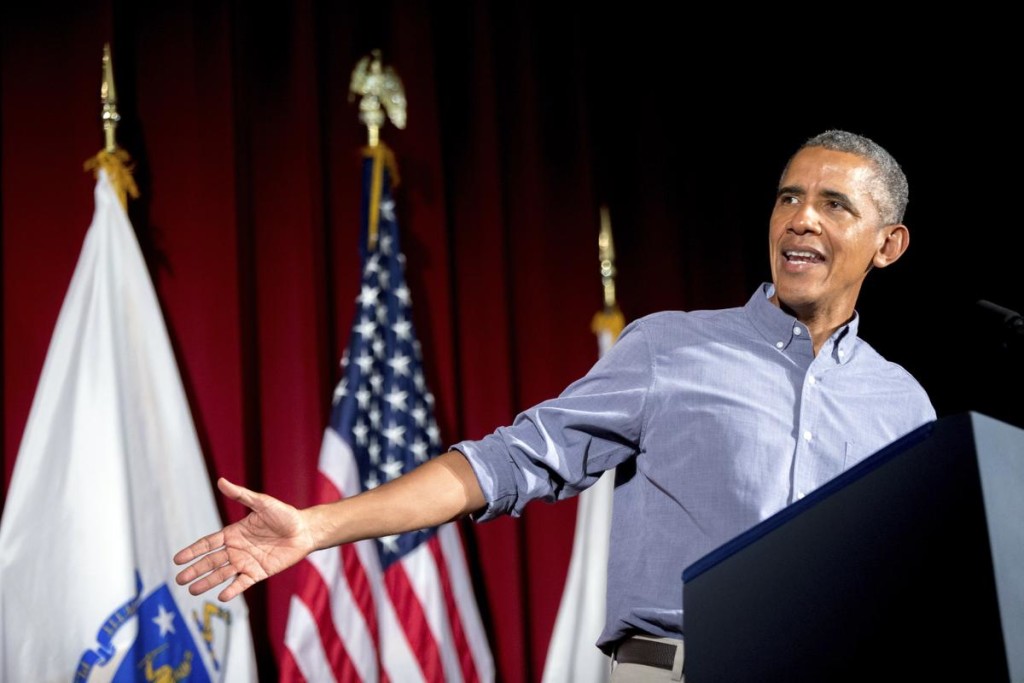
Image credit: Obama at the Greater Boston Labor Council Labor Day Breakfast (09.07.2015). Photo by Andrew Harnik of the Associated Press.
According to businessinsider.com Obama will be signing an executive order today which covers paid leave for employees working under federal contracts.
It appears that employees will receive one (1) hour of paid leave for every thirty (30) hours that they work. The paid leave can also be used to care for sick family members.
This executive order will cover federal contracts which start in (and after) 2017.
I myself am all for paid leave. Happy Labor Day 2015!
Please exercise your free speech in the comments section below. There are no stipulations of political correctness on this blog. Speak your mind, give us your thoughts, both objective and subjective. Share your ideas, hunches, inklings or your expertise. Please provide recommendation and corrections if you spot errors in fact within the blog report. Lastly, remember that posting a comment is much like casting a vote, so please do so.









Paid Sick Leave Executive Order for Federal Contractors Drafted
SHRM / Society for Human Resource Management
Allen Smith
8/7/2015
Excerpt:
The White House is reviewing a draft executive order (E.O.) that would require federal contractors and subcontractors to provide up to seven days of paid sick leave annually to employees on government contracts. The sick leave would include paid time for family care.
Paid sick leave may not sound like a big deal, but employers are concerned that it will pose significant administrative headaches and coordination-of-leave challenges, in addition to requiring policy changes.
Although the draft is marked “predecisional and deliberative,” President Barack Obama articulated his support of paid sick leave in his 2015 State of the Union address.
“Today, we are the only advanced country on Earth that doesn’t guarantee paid sick leave or paid maternity leave to our workers,” he said. “Forty-three million workers have no paid sick leave—43 million. Think about that. And that forces too many parents to make the gut-wrenching choice between a paycheck and a sick kid at home.”
In addition to mentioning that he would help states adopt paid sick leave laws (California has enacted such legislation), Obama challenged Congress: “Send me a bill that gives every worker in America the opportunity to earn seven days of paid sick leave. It’s the right thing to do.”
But in a news statement, the Society for Human Resource Management (SHRM) said, “We have strong concerns with mandating paid sick leave through an executive order on federal contractors. Many contractors already provide paid sick leave. Leave mandates often result in employers scaling back leave coverage to conform to mandated minimum standards.”
SHRM stated further that “rather than crafting flexible leave policies that meet the needs of their individual workforces, employers tend to restructure their policies to meet only the requirements enumerated by the government. We don’t believe this type of mandated approach helps employers or employees.”
Also, while Obama cited 43 million in his State of the Union address as not having paid sick leave, SHRM noted that the figure counts paid sick leave, not paid time off that can be used for any purpose, such as an illness, a vacation or a mental health day. SHRM and the Families and Work Institute did a survey this year indicating that “almost all U.S. employers with 50 or more employees (99 percent) have some form of time off with pay for their full-time employees.”
Provisions of Draft Order
Under the draft executive order, paid sick leave would be available for:
Paid sick time would carry over from one year to the next and be reinstated for employees rehired by a covered contractor within 12 months after a job separation.
The paid sick time would have to be provided in response to an oral or written request made, if possible, at least seven calendar days in advance.
Certification by a health care provider for paid sick time may be required only for paid sick time for three or more consecutive workdays under the draft order. And the certification would be provided no later than 30 days from the first day of the leave.
The draft order also provides that its mandate shall not excuse noncompliance with any law, ordinance or collective bargaining agreement that requires greater paid sick time or leave rights.
Department of Labor regulations implementing the order would be required by Sept. 30, 2016, under the draft. And the order would apply to contracts initiated on or after Jan. 1, 2017.
Administrative Concerns
Employers have a number of concerns about the paid sick leave draft executive order, noted Cheryl Behymer, an attorney with Fisher & Phillips in Columbia, S.C.
She said that administrative tracking and coordination may be challenging. “The draft E.O. says that Davis-Bacon Act (DBA) and Service Contract Act (SCA) contracts will be covered in the relevant threshold amounts covered in those statutes and that procurement contracts subject to the Fair Labor Standards Act will be covered if they exceed the micro-threshold amounts. Thus, employers might struggle with determining to which contracts the requirements apply.”
An additional administrative issue involves which employees are entitled to the leave, she observed. “Draft Section 2(a) follows the standard DBA/SCA language where the benefit applies to ‘all employees, the performance of the contract or subcontract.’” This means that the employer will need to track which employees are actually working on contract or subcontract.
“While this may be done already through the DBA/SCA requirements, if the employer has opted to just make the DBA/SCA wage payments to all employees, it will either need to do the same with the paid sick leave so that employees not entitled also receive it or to set up a tracking procedure,” she said.
She added that the language is not clear about whether paid leave is only for the hours worked on government contract work or total hours worked. This makes a difference for employees whose work only sometimes involves performing work on a government contract.
Coordination of Leave
Then there are the coordination-of-leave challenges the order would raise, Behymer added.
For example, the Family and Medical Leave Act (FMLA) exempts from coverage employees working at establishments with fewer than 50 employees.
“There does not appear to be any similar exemption contemplated for the draft executive order,” Behymer remarked. “Thus, small employers would still be required to track and award this paid leave, even where they are not covered under the FMLA.”
…………………………………………….
View the complete document at:
http://www.shrm.org/legalissues/federalresources/pages/draft-paid-sick-leave-order.aspx
I don’t have any major objections to the INTENTION of Obama’s drafted executive order regarding ‘paid sick leave’ for federal contractors except to emphasize to readers that “the devil involved in government regulations is often in the details”.
If the order is to be implemented to accomplish the intended results, it should be crafted to provide the minimum negative impact on the federal contractors.
Based on the information provided above in the SHRM document, it appears that some further clarification and modification needs to be conducted regarding some of the details contained in the executive order.
THE DEVIL IS OFTEN IN THE DETAILS
‘CLAIMED FACT’ – as reported to the American People by our MSM:
‘PROVEN DETAILS’
Barack Hussein Obama II was born August 4, 1961 at the Coast Province General Hospital in Mombasa, as shown on the below reproduced high-resolution copy of his authentic Kenyan Birth Certificate.
Obama is a LIAR, FRAUD and IMPOSTER
The American People need to be informed of all the DETAILS regarding Obama’s Radical Left-Wing Background, Forged Hawaiian Long-Form Birth Certificate, Forged Selective Service Registration and likely Stolen Social Security Number.
http://www.wasobamaborninkenya.com/1961%20Kenyan%20Birth%20Certificate%20of%20Barack%20Hussein%20Obama%20II,%20Copy.pdf
The end of restaurant tipping?
MarketWatch
Charles Passy, Reporter & Angela Moore, Personal finance editor
10/16/2015
Excerpt:
Is the no-tip movement at restaurants reaching, well, a tipping point?
Danny Meyer, who runs the Union Square Hospitality Group, announced this week he’s going to phase out tipping at his restaurants and instead, raise prices so employees working across the restaurants will earn a higher wage.
Meyer’s restaurant empire includes high-end eateries like Blue Smoke, Gramercy Tavern, North End Grill, Union Square Cafe and Maialino. The first restaurant to participate will be The Modern, in late November. The rest of the group’s New York restaurants will transition over the next year.
The move comes on the heels of a pledge from New York state to raise the minimum wage for fast-food workers to $15 an hour, echoing a call across the country for a higher minimum wage.
Diners shouldn’t feel squeezed, Meyer says, and the change will be an improvement for those working at all levels of the restaurant. For example, some positions, such as cooks and dishwashers, weren’t eligible for tips, even though their efforts contribute to the overall enjoyment of a meal, Meyer says. His aim is that this will allow workers to be more fairly compensated.
“Once these changes are implemented, the total cost you pay to dine with us won’t differ much from what you pay now. But for our teams, the change will be significant,” Meyer’s letter says. “We will now have the ability to compensate all of our employees equitably, competitively, and professionally.”
Meyer isn’t alone. In recent years, such renowned restaurants as Thomas Keller’s Per Se in New York and French Laundry in Yountville, Calif., Alice Waters’s Chez Panisse in Berkeley, Calif., and Grant Achatz’s Alinea in Chicago have put no-tip policies in place. So did the now-closed Linkery restaurant in San Diego.
Perhaps the policies at these establishments shouldn’t come as a surprise, since restaurant patrons are increasingly saying they don’t like to play the tipping game. A solid majority of Americans — 75% — say they tip less than the customary 20% when dining out, according to a survey by vouchercloud.net, which researches consumer spending habits. Additionally, the website reports that 46% of Americans say they are tipping less in general than they did five years ago.
……………………………………..
View the complete article, including images, at:
http://www.marketwatch.com/story/the-end-of-restaurant-tipping-2015-10-15